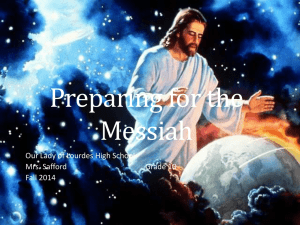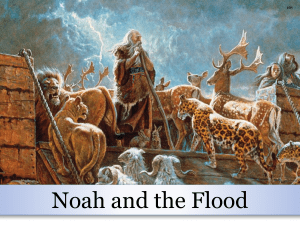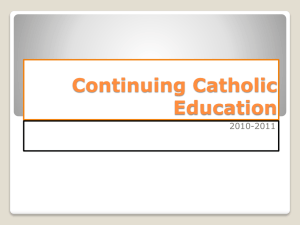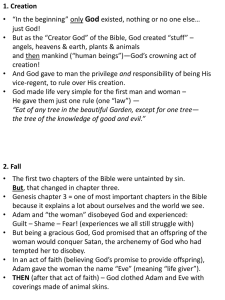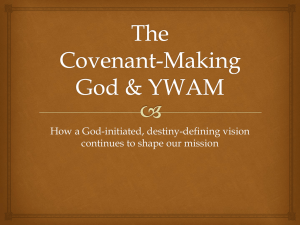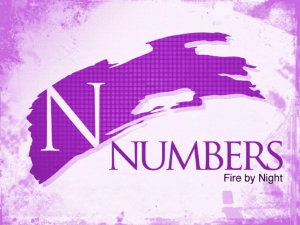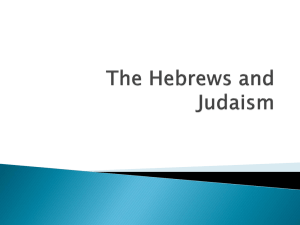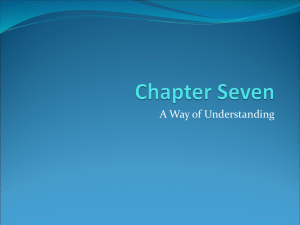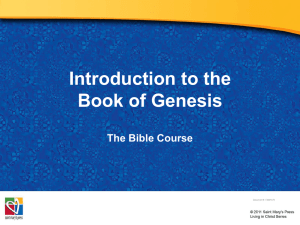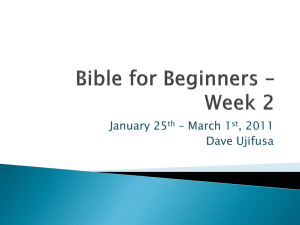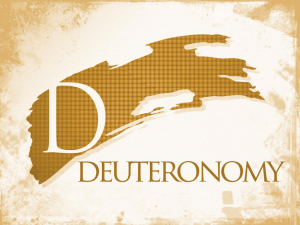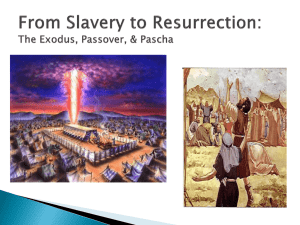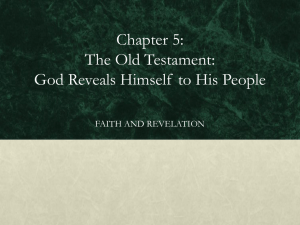Chapter 1: Knowing God Through Natural Revelation, Reason, and
advertisement
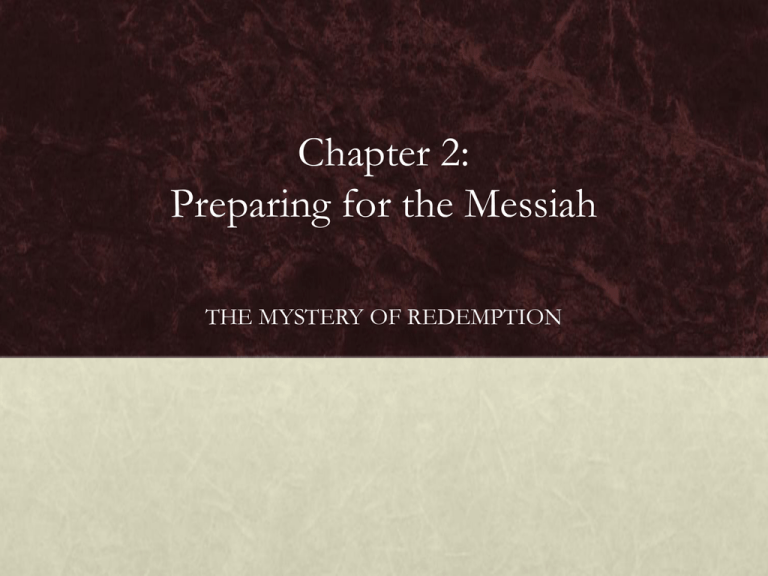
Chapter 2: Preparing for the Messiah THE MYSTERY OF REDEMPTION 1. The Promise of Redemption ANTICIPATORY SET Have the students look over the questions identified under “This chapter will address . . .” (p. 36), and have them free write about the one they currently know the most about. Share responses. 1. The Promise of Redemption BASIC QUESTIONS Who are the persons referred to in the Genesis Protoevangelium? What is the felix culpa? What are the senses in which the Sacred Scriptures can be read? How does Cain illustrate the transmission of Original Sin? KEY IDEAS The Protoevangelium or “First Gospel” in Genesis promises that Christ, the New Adam, the seed of the woman Mary, the New Eve, will overcome the Devil and bring salvation. The Fall of Adam and Eve is the “felix culpa,” or happy fault, because it resulted in the Incarnation of Christ. The Old Testament can be read in the literal, allegorical, moral, and anagogical senses. Cain showed the fruits of Original Sin when he murdered his brother Abel. 1. The Promise of Redemption FOCUS QUESTIONS What does it mean to say that God created Adam and Eve in a state of original holiness and justice? It means they had a share in God’s own life and were in a right relationship with God, each other, and the rest of creation. What are preternatural gifts? They are gifts that go beyond a creature’s nature but which are not strictly supernatural. For example, if a dog were given the ability to speak that would be preternatural for dog nature. For a human being to be immune from physical death is preternatural for a human being but a quality natural for an angel. Sanctifying grace is strictly a supernatural gift. 1. The Promise of Redemption GUIDED EXERCISE Have the students free write for a few minutes on which effect of Original Sin they think is the worst and why. 1. The Promise of Redemption FOCUS QUESTIONS From the point of view of Christianity, who are the woman, her seed, and the serpent in Genesis 3:15? They are, respectively, Mary, her son Jesus Christ, and the Devil. Why is this passage rightly called the Protoevangelium? Protoevangelium means “first good news” or “first gospel,” and these words are the first prophecy of the Messiah. 1. The Promise of Redemption FOCUS QUESTIONS How is Jesus the New Adam? Christ is the “New Adam” because his obedience made amends for the disobedience of the first Adam. How is Mary the New Eve? Mary’s humble “yes” to the angel’s message brought salvation to the world, undoing Eve’s “no” to God’s command, which brought sin and suffering. 1. The Promise of Redemption GUIDED EXERCISE Conduct a think/pair/share on the following question: How are both Eve and Mary “the Mother of the living”? 1. The Promise of Redemption FOCUS QUESTIONS What does it mean to say that sin proliferated in the ancient world? It means that it both spread and increased in gravity. Why did the early Church think God permitted the Fall of Adam and Eve? They reasoned that God permitted it to bring about a greater good. The good that will come about by Christ’s Incarnation and redemption is greater than the good that would exist if Adam and Eve had never fallen. What is the “felix culpa”? It literally means “happy fault.” It refers to the Original Sin, the fault of our first parents, which resulted in Christ becoming our Savior. 1. The Promise of Redemption FOCUS QUESTIONS What is the difference between a literal and a literalistic reading of Sacred Scripture? A literal reading means to read the passage the way the author intended it to be read. A literalistic reading does not take into account genre or literary technique. Extension: A literal reading of “it was raining cats and dogs” is that it was raining very hard. A literalistic reading is that cats and dogs were actually falling out of the sky. What are the two basic ways the early Church distinguished for reading the Sacred Scriptures? The literal and the spiritual. What is the literal sense of Scripture? The literal sense is what the Sacred Author, inspired by the Holy Spirit, intended to express; it is the most immediate and direct meaning of the text. 1. The Promise of Redemption FOCUS QUESTIONS What are the three spiritual senses of Scripture, and what does each mean? (1) The allegorical or typical sense shows how people and events in salvation history parallel future people or events. (2) The moral or tropological sense interprets the heroes of Scripture as models for life. (3) The anagogical sense elucidates knowledge of Heaven through the events of Sacred Scripture. What is the most important sense of Scripture? The most important is the literal, since the spiritual senses are based on the literal sense. 1. The Promise of Redemption FOCUS QUESTIONS How did God’s regard for the sacrifices of Cain and Abel differ? God had “regard” for the firstling animal offerings of Abel but not for the agricultural offerings of Cain. How is Cain a witness to the reality of Original Sin? Cain murdered his brother out of anger and envy. How does God show mercy to Cain after banishing him? He gave Cain a “mark,” which promised sevenfold vengeance on anyone who killed Cain. 1. The Promise of Redemption GUIDED EXERCISE Conduct a think/pair/share on the following question: What did God mean when he told Cain (p. 42), “If you do well, will you not be accepted? And if you do not do well, sin is couching at the door; its desire is for you, but you must master it” (Gn 4:7)? 1. The Promise of Redemption CLOSURE Have the students write a paragraph explaining the Protoevangelium in terms of the felix culpa. 1. The Promise of Redemption HOMEWORK ASSIGNMENT Reading The Descendants of Seth through The Covenants Prepare God’s People for Redemption (pp. 42–43) Study Questions Questions 1-9. Practical Exercise 1. Workbook Questions 1–6. 1. The Promise of Redemption ALTERNATIVE ASSESSMENT Have the students work with a partner to write a dialogue between Adam and Eve when they learn of Cain’s slaying of Abel. Share responses. 2. Man’s Early Immortality ANTICIPATORY SET Incorporate the second creation account from Genesis (the creation of Eve) into the class’s opening prayer (Gn 2:4–25). Have the students free write on what this passage might be telling them about God’s original intention for marriage. 2. Man’s Early Immortality BASIC QUESTIONS Who is Lamech? Who is Seth? What are covenants in the Old Testament? KEY IDEAS Lamech, the first polygamist and a violent killer, illustrates how sin proliferated in the primitive world. Seth’s lineage, unlike Cain’s, began in righteousness, but it too became corrupted. God instituted his plan for the redemption of man by entering into covenants with individuals and groups of people who would be ancestors of Jesus Christ. 2. Man’s Early Immortality FOCUS QUESTIONS What did the sacred writer mean when he wrote that God “regretted” creating man and woman? He indicated God’s “sadness” that man rejected him and his laws and were blocking the way to their own happiness. For what two sins is Lamech infamous? He is the first recorded polygamist, and he was a violent killer. Why is polygamy especially bad on women? Women become objects of lust and domination. The husband withholds the exclusive affection owed to the one wife. What does it mean to “call upon the name of the LORD”? It means to please him by obeying his commands and to give him glory. 2. Man’s Early Immortality FOCUS QUESTIONS How does Genesis stress the dignity of the children of Adam and Eve in Seth’s case? Seth was the son of Adam, made in Adam’s image and likeness. Adam was the son of God, made in God’s image and likeness. How are Seth’s descendants described in Genesis? They are called “sons of God.” What is the meaning of Genesis 6:1–3? The line of Seth became corrupted by polygamy as the “sons of God” (the descendants of Seth) and “the daughters of men” (the descendants of Cain) intermarried. How did God punish early man for his evil? He shortened man’s life span. 2. Man’s Early Immortality GUIDED EXERCISE Have the students read Genesis 6:5–6: Then conduct a class discussion on the following question: To what extent could it be argued that the very same thing could be said about the age in which we live? 2. Man’s Early Immortality GUIDED EXERCISE Have each student work with a partner to complete a paragraph shrink on the paragraph “These covenants between . . .” (p. 43). 2. Man’s Early Immortality CLOSURE Have the students write a paragraph illustrating why God “regretted” creating man. 2. Man’s Early Immortality HOMEWORK ASSIGNMENT Reading The Covenant with Noah through the sidebar The Tower of Babel (pp. 44–47) Study Questions Questions 10-13. Practical Exercise 2. Workbook Questions 7-8. 2. Man’s Early Immortality ALTERNATIVE ASSESSMENT Have the students search the Internet to learn about the effects of divorce in modern society. Have the students share findings. Point out that divorce is only one of the violations of the marriage covenant. Ask the students to estimate the effect of all the violations of God’s plan for marriage and the family on individuals and society. 3. The Covenant with Noah ANTICIPATORY SET Have the students read the story of Noah (Gn 6—8:17) and then conduct a class discussion to identify moral and spiritual truths that God and the Sacred Author seem to be trying to communicate. 3. The Covenant with Noah BASIC QUESTIONS What is the significance of Noah and the deluge? How did Noah’s descendants behave? How does the disunity of the human race relate to salvation history? KEY IDEAS God saved the world in the person of the one righteous man, Noah, and made a covenant with him. The Flood is a “type” of Baptism. Noah’s children spread their arrogance throughout the world, with a good remnant preserved in the line of Shem, the ancestor of Abraham. The disunity of the human race into nations, languages, and peoples is meant temporarily to curb human pride. 3. The Covenant with Noah GUIDED EXERCISE Conduct a think/pair/share on the following question: Why does God decide never again to curse the ground because of man, according to Genesis 8:21? 3. The Covenant with Noah FOCUS QUESTIONS How was Noah different from the rest of men? “Noah was a righteous man, blameless in his generation,” and he “walked with God.” What is the significance of the number forty in Sacred Scripture? The number forty is frequently used in both the Old and New Testaments to symbolize a period of trial, testing, preparation, or penance. What is the new “divine economy” that begins at the time of Noah? Because sin had destroyed human unity, God sought to save humanity part by part, dealing with them in their various groupings. 3. The Covenant with Noah FOCUS QUESTIONS How is Noah’s flood a “type” of Baptism? The flood symbolically represents the cleansing power of Baptism achieved through Christ’s redemption: the waters of the flood destroyed the sins of the old creation and opened the way for a new creation, just as the waters of Baptism wash away our sins and create us anew. Of what are the “clean animals,” which Noah sacrificed after the flood, a “type”? They are a type of the sacrifice of Christ, who was the sinless and perfect Lamb of God. 3. The Covenant with Noah GUIDED EXERCISE Have the students write a paragraph on what Genesis 9:5–6 seems to be saying about violence and capital punishment. 3. The Covenant with Noah FOCUS QUESTIONS What command that God gave to Adam and Eve did God repeat to Noah and his sons? To “be fruitful and multiply, and fill the earth.” What foods does God give humanity to eat in the Noahic covenant? Plants and animals, except for the blood of animals. 3. The Covenant with Noah GUIDED EXERCISE Have the students work with a partner to summarize the terms of the covenant God made with Noah and his descendants. 3. The Covenant with Noah GUIDED EXERCISE Have the students work with a partner to paraphrase the following statement from CCC 57 in order to clarify its meaning: [B]ecause of sin, both polytheism and the idolatry of the nation and of its rulers constantly threaten this provisional economy with the perversion of paganism. 3. The Covenant with Noah FOCUS QUESTIONS How do the descendants of Noah divide into a good line and an evil line? Shem continued the righteous lineage that would eventually become God’s Chosen People. Ham’s line became the idolatrous Canaanites, the traditional enemies of the Hebrews. What was the reason for the division of languages, according to Genesis? It was a temporary and partial measure to curb human pride and sin. Why is the disunity of the human race only provisional? God wants to reunite the human family under Christ. 3. The Covenant with Noah CLOSURE Have the students write a paragraph summarizing the most important truths that can be gleaned from the stories of Noah and the Tower of Babel. 3. The Covenant with Noah HOMEWORK ASSIGNMENT Reading God’s Covenant with Abraham through St. Teresa Benedicta of the Cross (pp. 47–49) Study Questions Questions: 14-19. Workbook Questions 9-11. 3. The Covenant with Noah ALTERNATIVE ASSESSMENT Have the students free write for a few minutes on how the history of Europe in the twentieth century could be described as “idolatry of the nation and of its rulers.” 4. God’s Covenant with Abraham ANTICIPATORY SET Incorporate the sacrifice of Isaac into the class’s opening prayer (Gn 22:1–18) then have the students free write for a few minutes on what aspect of the story most surprised them. Briefly share responses. 4. God’s Covenant with Abraham BASIC QUESTIONS What was God’s covenant with Abraham? KEY IDEAS God chose Abraham and made a covenant with him to be the father of a new nation, his Chosen People, through whom he would reveal himself to mankind. 4. God’s Covenant with Abraham FOCUS QUESTIONS Who are the father and mother of the Israelite people? Abraham and Sarah. What things did God say to Abram when he first called him in Genesis 12:1–3? God told Abram to leave his family and go to a land God would show him. There he would make him a great nation. God would bless him and make his name so great that he would be a blessing for the whole earth. God would reward those who blessed Abram and punish those who cursed Abram. What seemingly impossible thing did God promise Abraham? That he and his wife, both very old, would have a son. How would Abraham be like Adam and Noah? Abraham would become the father of a chosen and divinely favored people. 4. God’s Covenant with Abraham GUIDED EXERCISE Have the students perform a focused reading on the paragraph beginning, “This famous Old Testament story . . .” (p. 48). 4. God’s Covenant with Abraham FOCUS QUESTIONS Why was God’s command that Abraham sacrifice his son Isaac both challenging and inexplicable? Isaac was the son through whom Abraham was to become a great nation, but how could that be if Isaac was dead before he even had one child of his own? Extension: God’s command was also challenging and inexplicable because (1) a father was being asked to kill his own son, which goes against human nature, and (2) God was directing a man to do something immoral, which would mean that God was evil. 4. God’s Covenant with Abraham FOCUS QUESTIONS What does God promise Abraham because of his fidelity and generosity? God promises (1) he will bless Abraham; (2) Abraham’s descendants will be countless; (3) Abraham’s descendants will rule over their enemies; and (4) by Abraham’s descendants all the nations of the earth will be blessed. How would God reveal himself from this point onward? God would reveal himself through the descendants of Abraham: the patriarchs, judges, and prophets of the Chosen People, and finally through Jesus Christ. 4. God’s Covenant with Abraham GUIDED EXERCISE Have the students write a paragraph describing Edith Stein’s life as a journey from Judaism to atheism to Catholicism. 4. God’s Covenant with Abraham FOCUS QUESTIONS What is the sign of the covenant with Abraham? Circumcision. What is the relationship between circumcision and the Passion of Christ? The blood that was shed by the males who entered into the Abrahamic covenant served as a remote prototype for the blood shed by Christ in establishing the New Covenant. 4. God’s Covenant with Abraham CLOSURE Have the students write a paragraph summarizing God’s covenant with Abraham. 4. God’s Covenant with Abraham HOMEWORK ASSIGNMENT Reading The Covenant with Moses through The Promised Land (pp. 50–55) Study Questions Questions: 20-25. Practical Exercise 3. Workbook Questions 12-13. 4. God’s Covenant with Abraham ALTERNATIVE ASSESSMENT Have the students explore Practical Exercise 3 through a class discussion on the virtue of faith. The following questions may be used to help frame a discussion: What is faith? Have I ever felt I was losing my faith? What do I think brought this about? Where should I go for help when I have doubts or questions about my faith? 5. God’s Covenant with Moses ANTICIPATORY SET Read the institution of the Passover in Exodus 12:1–28. Explain that the Israelites considered the Passover to be one of the fundamental events in Jewish history because it marks their liberation from slavery. Also, point out why Christians consider it central: it prefigures the Passion of Christ, the Mass, and the Eucharist. 5. God’s Covenant with Moses BASIC QUESTIONS Who was Moses? What was the Jews’ early experience in the Promised Land? KEY IDEAS God revealed his name to Moses, God’s prophet who led the Chosen People out of slavery in Egypt through the Red Sea after the Passover. Through Moses, God also revealed the Decalogue, the moral law that was the basis of the Covenant God established with the Israelites. In the Promised Land, Israel faced the constant temptation to be unfaithful to God by idolatry. 5. God’s Covenant with Moses GUIDED EXERCISE Have the students perform a focused reading on the paragraph beginning, “This disclosure of the Divine Name, . . .” (p. 51) using the following question: Why is God’s disclosure of his name important? 5. God’s Covenant with Moses FOCUS QUESTIONS Were all of Abraham’s descendants part of the Chosen People? No. Only those descendants of Jacob (Israel). What is the origin of the Twelve Tribes of Israel? The twelve sons of Jacob. How did God save the Chosen People through Joseph? Although his brothers sold him into slavery, Joseph became powerful in Egypt and was able to provide food for his entire extended family in a time of famine. 5. God’s Covenant with Moses FOCUS QUESTIONS Why did Pharaoh decide to enslave the Israelites and then to kill all the Hebrew male children? The pharaoh was afraid of the growing power of the Hebrews. How was Moses educated? He was raised as both a Jew and an Egyptian prince. Why did Moses flee Egypt? He killed an Egyptian who was abusing a Hebrew and was afraid his crime would be detected. 5. God’s Covenant with Moses FOCUS QUESTIONS What is the burning bush? It was the miraculous occurrence in which a bush burned without being consumed and out of which Moses heard God speaking. How did Moses respond to God’s choice to send him to deliver the Chosen People from slavery? Moses argued that God had chosen the wrong man. What is the name of God, which God revealed to Moses? I AM WHO I AM. 5. God’s Covenant with Moses GUIDED EXERCISE Have the students complete the following table to help them understand the seven names of God in Sacred Scripture. Name Elohim Yahweh Adonai Theos Kyrios Despotes Father Translation Significance 5. God’s Covenant with Moses GUIDED EXERCISE Name Translation Significance Strong Ones Evokes majesty and hints at the three Persons of the Blessed Trinity. Denotes God’s sovereignty, creative work, and mighty work for Israel. Yahweh I AM WHO I AM Stresses God as independent and self-existent. Adonai Majesties Emphasizes God’s relationship to man as master, authority, and provider. Theos God Stresses God is the only true God: unique, transcendent, and the Savior. Kyrios Lord Points to authority and supremacy. Master Stresses ownership. (N/A) Emphasizes God’s loving care, provision, discipline, and the way we are to address God in prayer. Elohim Despotes Father 5. God’s Covenant with Moses GUIDED EXERCISE Have the students complete the following table to help them see how various details of the Exodus foreshadow the Sacrifice of Christ. Detail Nature of sin Friendship Message Slaying of firstborn son Passing through water Moral code Exodus Sacrifice of Christ 5. God’s Covenant with Moses GUIDED EXERCISE Detail Exodus Sacrifice of Christ The Chosen People were oppressed under the bondage of the Egyptians from which God liberated them. Humanity was burdened with the oppression of Satan and sin, from which Christ liberated humanity. Moses enjoyed God’s friendship. Jesus Christ was even more than a friend of God as consubstantial Son of God. Message Moses transmitted the revealed Word of God to Israel. Jesus, the Word of God, fully reveals the Father. Slaying of firstborn son God spared the firstborn of the Israelites by substituting a sacrificial lamb. The sacrificial lamb in the redemption is Christ himself. Passing through water Israel passed through the Red Sea to become. Baptism is a passing through water to liberation from sin and death. God gave Moses the Ten Commandments. Christ gave the Law of Love. Nature of sin Friendship Moral code 5. God’s Covenant with Moses FOCUS QUESTIONS Why did God send plagues to Egypt? To force the pharaoh to release the Chosen People from Egypt. What was the final and worst plague? The death of every firstborn male among the Egyptians, animal and human. Extension: This is exactly what the Egyptians did to the Jews. How did the Jews escape their own sons being killed in the Passover? God protected the firstborn sons of the Israelites by instructing them to offer a male lamb as a substitute. The head of each family smeared the lamb’s blood on the doorposts and lintel of his house, so that the angel of death would “pass over” that home and spare that household’s firstborn son. 5. God’s Covenant with Moses FOCUS QUESTIONS What does the crossing of the Red Sea represent for the Chosen People? The passing from slavery to freedom, from a land of oppression to the Promised Land of milk and honey. What is the Decalogue? The Ten Commandments God gave Moses on Mt. Sinai, the basis of the Mosaic Covenant. 5. God’s Covenant with Moses FOCUS QUESTIONS What are the two divisions of the Decalogue? Three Commandments detail the proper relationship that a person should have with God. Seven Commandments regard the relationships that a person should have with his or her neighbors. What is the relationship between the Decalogue and the natural law? The Decalogue is an articulation of the natural law. It didn’t have to be revealed but God chose to so that it would be easier to know his will. 5. God’s Covenant with Moses FOCUS QUESTIONS How long was it from the Exodus until the entry into the Promised Land? Forty years. What was the chief source of the difficulties Israel faced in the Promised Land? Their attraction to the riches and idolatry of their pagan neighbors. Why did Israel desire a king? They wanted someone who would protect them from their enemies and help them to have a prosperous life. Extension: These are what God himself promised them if they would only be faithful to their covenant. 5. God’s Covenant with Moses CLOSURE Have the students write a paragraph summarizing Moses’ importance for the Chosen People. 5. God’s Covenant with Moses HOMEWORK ASSIGNMENT Reading The Promise to David through Conclusion (pp. 55– 59) Study Questions Questions: 26-32. Workbook Questions 14-20. 5. God’s Covenant with Moses ALTERNATIVE ASSESSMENT Write a paragraph based on the completed graphic organizer on how the Exodus foreshadows the Sacrifice of Christ (p. 68a) identifying how these two events are related. 6. David and the Prophets ANTICIPATORY SET Incorporate Psalm 89 into the class’s opening prayer and then ask the students to identify promises God was making to David and his descendants in this psalm. 6. David and the Prophets BASIC QUESTIONS Who was David? What was the message of the prophets? KEY IDEAS David, a prototype of Christ, was the greatest king of the nation of Israel. Through the prophets, God warned Israel they would suffer for their infidelity but promised a future messiah. 6. David and the Prophets FOCUS QUESTIONS How can Old Testament persons reflect Christ even though they are sinners? Their lives show, in an analogous and allegorical way, Christ’s work of redemption. Who was the first King of Israel? Saul. How was David an unlikely choice for King of Israel? David was a youngest son and a shepherd. 6. David and the Prophets GUIDED EXERCISE Have the students explore various ways David was a prototype of Christ. Quality Shepherd Righteous King Wise Prayerful Savior Son of God David Christ 6. David and the Prophets GUIDED EXERCISE Quality David Christ David was a shepherd in his youth. Jesus is the Good Shepherd who lays down his life for his sheep. Though a sinner, David was a man after God’s own heart. Jesus was perfectly holy, being God. King David established a kingdom and founded a line of kings. Christ established the kingdom of Heaven. Wise David wrote wisdom literature, especially the Psalms. As God, Jesus is Wisdom itself. David was a man of prayer. Jesus was a man of prayer always in communion with his Father. David saved his people from all their enemies and made them a great nation. Jesus is the Savior of all mankind. God called David his son. Jesus is literally the Son of God. Shepherd Righteous Prayerful Savior Son of God 6. David and the Prophets FOCUS QUESTIONS What did David do for Israel as a nation? David made Israel a mighty nation for the first time, defeating all its enemies in battle. What is the significance of Jerusalem for the Chosen People? King David made it both the political and the religious capital of Israel, where his son Solomon later built the Temple to worship God. How does the idea of divine sonship change with David? Previously, the nation of Israel collectively was God’s son. Now, God calls David his son. 6. David and the Prophets FOCUS QUESTIONS Who was God ultimately referring to when he called David his son? God was referring to the heir of King David, his Only-Begotten Son, Jesus Christ. What chastisement did the prophets threaten against Israel? Being conquered by a foreign nation. What nation conquered and destroyed Jerusalem? Babylon. 6. David and the Prophets FOCUS QUESTIONS What did the prophets in general predict about the messiah? He would restore Israel, bringing her to an even greater splendor than that which existed under King David. What did Isaiah prophesy about the messiah? That he would suffer and die. What happened to Israel after Solomon? It was divided into two kingdoms. The immorality and idolatry of the Northern Kingdom (called Israel) ended with their complete destruction by the Assyrians. 6. David and the Prophets FOCUS QUESTIONS What was Judah? Along with the tribe of Benjamin, Judah was all that remained of the old Davidic kingdom. Extension: The name “Jew” is derived from the name of this tribe. What did Isaiah prophesy about Jerusalem? He predicted that Jerusalem would one day be the religious capital of the world. What did Isaiah prophesy about the birth of the messiah? He would be born of a virgin: “Behold a virgin shall conceive, and bear a son, and his name shall be called Emmanuel.” 6. David and the Prophets GUIDED EXERCISE Have the students work with a partner to read the sidebar “Christ, the Suffering Servant” (p. 57) and identify and explain three references to Christ. 6. David and the Prophets CLOSURE Have the students write a paragraph examining how David is a prototype of Christ using the graphic organizer “David and Christ.” 6. David and the Prophets HOMEWORK ASSIGNMENT Study Questions Questions: 33-40. Practical Exercise 4. Workbook Questions 21-25 6. David and the Prophets ALTERNATIVE ASSESSMENT Write a paragraph summarizing how God directed salvation history in the Old Testament. The End
